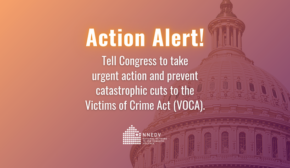Connecting the Dots: Stalking and Domestic Violence
February 7, 2020
Stalking is a serious issue affecting more than six million people each year. It can be a terrifying crime for those who experience it, and it is often one of many tactics that abusers use in order to maintain power and control over a current or former intimate partner.
Identifying Stalking Behaviors
The United States Department of Justice defines stalking as “engaging in a course of conduct directed at a specific person that would cause a reasonable person to fear for [their] safety or the safety of others or suffer substantial emotional distress.” Stalking often encompasses unwanted, repeated behaviors that are intended to surveil, monitor, threaten, and ultimately scare someone, such as:
- Communicating persistently via phone, text messages, or social media
- Sending unwelcome items or gifts
- Showing up repeatedly at someone’s home, school, or workplace
- Following someone in-person or via technology (like a GPS device or an app)
- Intentionally damaging someone’s property
- Threatening someone or their family, friends, or pets
Additionally, research shows that when victims experience both physical abuse and stalking behaviors, the risk for homicide is increased. Seventy-six percent of victims had been stalked by their partner beforehand, and 89 percent of femicide victims who had been physically assaulted had also been stalked in the year before their murder.
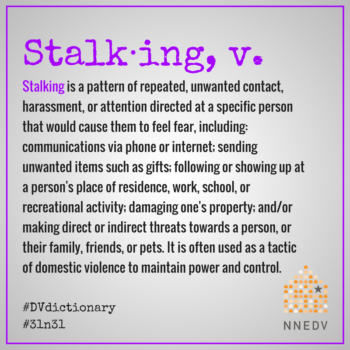
Normalizing Stalking in Pop Culture is a Problem
All too often, messages in the media portray stalking as an extreme, even desirable, display of love and devotion. Or, the behavior is minimized and normalized, attributed to a change in social norms that we should accept. For example, it’s exceedingly common to hear about someone “Facebook stalking” their ex or a potential love interest. You’ve probably also seen abusive stalkers idealized in popular culture (think: Edward Cullen, Christian Grey, Ezra Fitz—the list goes on). While it may seem harmless, the more we normalize and accept these messages, the harder it can be for victims of stalking to identify the harm they’re experiencing, to be believed if they disclose it, and to be supported if they choose to reach out for help.
The truth is that all partners in a healthy relationship need to feel safe and comfortable living their own lives, without a partner acting entitled to monitor their every move. A healthy relationship needs mutual trust, respect, and boundaries—and stalking doesn’t include any of those things. You can learn more about the characteristics of healthy, unhealthy, and abusive relationships here and here, and you can also check out our interview with stalking expert Dr. Julia Lippman here.
The good news is that you don’t have to be an expert on stalking or domestic violence to interrupt harmful messages when you hear them. Here are some things you can try:
- Start a conversation today. Simply by talking about domestic violence or stalking in a supportive manner, you can help erase the stigma. Download our 10 Tips to Have an Informed Conversation about Domestic Violence.
- Suggest a book for your book club. NNEDV’s book club, Reader with a Cause, has plenty of suggestions—many with discussion guides ready to go! You can also join our virtual book club on Goodreads to join these conversations today.
- Host a #DVMovieNight. Check out our Pinterest board for movie ideas and use our Movie Night Conversation Guide to talk about the themes from the movie.
- Engage on social media during Stalking Awareness Month each January. Take a look at #NSAM2020 to see how you can amplify and get involved with organizations in this space.
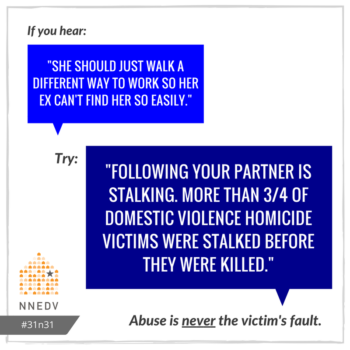
Technology and Stalking
Technology is a critical part of our lives and can be strategically used by survivors to increase their privacy and safety. It can be an essential tool for staying connected to family and friends, which is often difficult when you’re experiencing abuse. A survivor’s job (and potentially their only source of income) may be reliant on technology. Survivors also research domestic violence, access direct services, or otherwise reach out for help online or using a variety of devices. And, for survivors with disabilities, technology can facilitate communication, education, work, and more.
Unfortunately, abusers also frequently misuse technology as a tool to stalk victims. Additionally, there are many privacy concerns that exist in today’s digital age. These include possibilities for abusers and stalkers to access and gather personal information about a survivor—even those who are not actively online. This means that it is important for direct service professionals and survivors to consider how technology and can impact safety and privacy when trying to address abuse.
NNEDV’s Safety Net project has worked to address the intersection of domestic violence and technology safety for nearly two decades. Through this work, we:
- Work with communities, agencies, and technology companies to address how ongoing and emerging technology impacts the safety, privacy, and accessibility rights of victims.
- Educate victim advocates and the general public on ways to use technology strategically to increase and maintain safety and privacy.
- Train law enforcement and justice systems, social services, coordinated community response teams, and others on tactics of technology misuse and offender accountability.
- Advocate for strong local, state, national, and international policies that ensure the safety, privacy, and civil rights of all victims and survivors.
Our Tech Safety App provides tools and resources for advocates and victims of technology-facilitated abuse, including stalking. If you are a victim of stalking, you can check out our documentation tips for survivors of technology abuse and stalking. You can also take a look at our key technology safety initiatives and read more about the other ways we’re addressing technology-facilitated stalking.
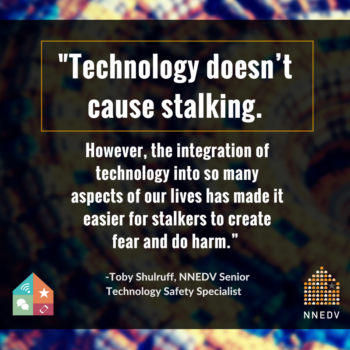
Help is Available: Stalking Resources
If you or someone you know has experienced stalking, there are resources available to help and support you:
- The National Domestic Violence Hotline offers 24/7 chat and phone services if you want to talk to an advocate about what you’ve experienced, get more information about local resources and services providers, and explore safety-planning options if you’re in an unsafe situation. You can also read more about their stalking safety planning tips.
- The StrongHearts Native Helpline is a culturally-appropriate helpline for Native Americans who have questions or concerns about domestic violence and dating violence, including stalking.
- VictimConnect is a referral helpline program of the National Center for Victims of Crime where victims of crime (including stalking) can learn about their rights and options confidentially and compassionately.
- The Stalking Prevention, Awareness, and Resource Center (SPARC) also offers a number of resources for victims, as well as training and specialized knowledge for professionals wanting to learn more about identifying and responding to stalking among the communities they serve.
- WomensLaw.org (a project of NNEDV) provides legal information and support to victims of domestic violence and sexual assault—including stalking—in both English and Spanish. WomensLaw also provides a number of stalking-related resources—including safety planning tips for stalking victims—and answers questions from survivors and advocates, like Can I get a restraining order if I’m being stalked? and What exactly is stalking and cyberstalking?
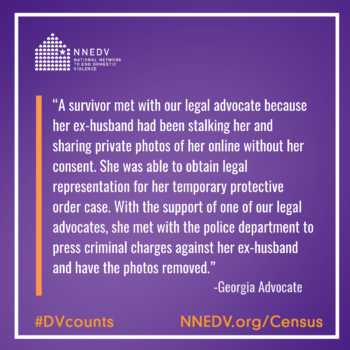
Learn how local domestic violence advocates are responding to stalking and other forms of abuse in our Domestic Violence Counts annual census.





